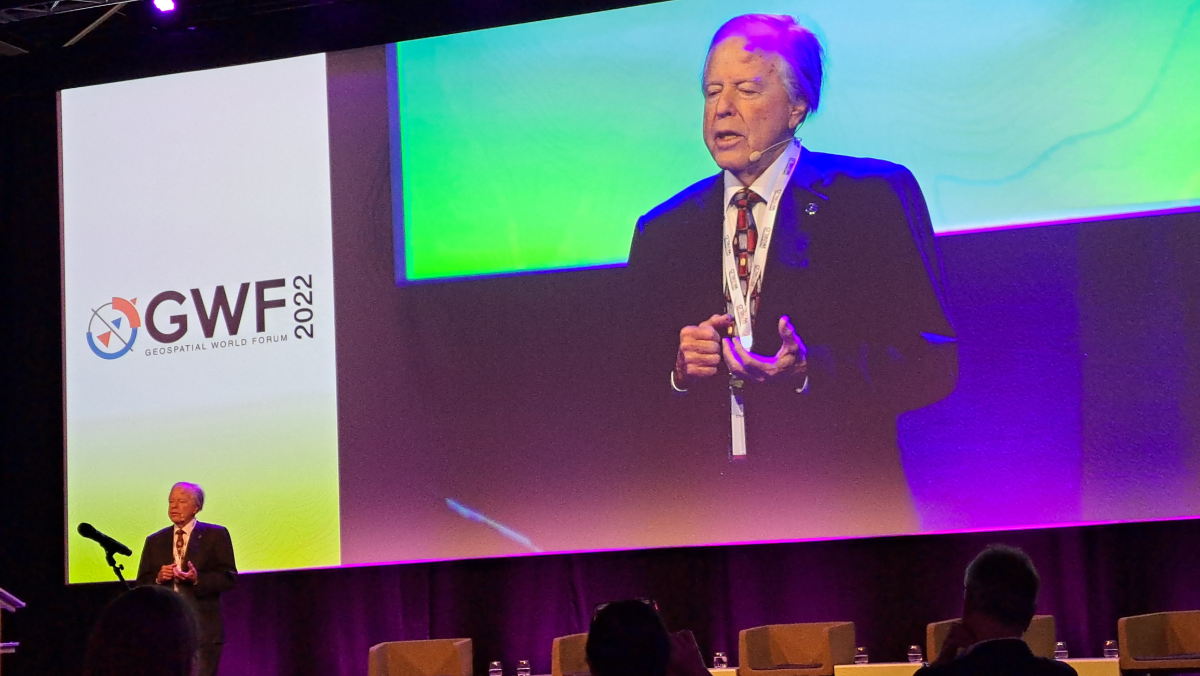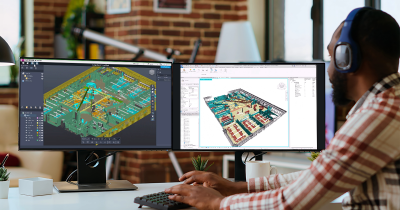Geospatial World Forum 2022, held in Amsterdam, gathered together some of the preeminent leaders in the geospatial arena - from pioneers of technology to futurists and people working on huge, high-level digitization and geospatial data projects. In an opening session, Charles “Charlie” Trimble, founder of Trimble and visionary on the use of GPS receivers outlined a fascinating history of geospatial innovation. In his talk, Trimble connected three events as key moments in the evolution of position, navigation and timing (PNT).
“Sputnik led to the need for global navigation systems, the shuttle disaster led us to the realization that we were dealing with the satellite system as an information utility, and now the integration of PNT into mobile internet and cloud is changing our world.”
In 1976, the first GPS test satellite was launched and eight years later, Timble, a fledgling startup sold the first commercial GPS receiver. At the time there were only five GPS satellites in the sky- and early applications were niche markets like oil survey or synchronizing timing centers. In January of 1986, the year of the Challenger space shuttle disaster, there were only seven GPS satellites in orbit and the system was put on an indefinite hold. This put an unknown delay in the widespread use of GPS for navigation, but for Trimble, it provided an unexpected opportunity.
“The silver lining was that it compelled us to think deeply about the value proposition of GPS. We realized that the data we were getting from geo-tagging things and timestamping events possessed useful information for connecting things in space and time.”
Later in the conference, we got a rare chance to catch up with Charlie to get some more insight on the past - and the future - of geospatial technology.
Looking at the GPS and markets today, back when you invented the first commercially available GPS receiver, did you anticipate some percentage of what it would become today?
No, of course not. {laughs}
I tried to - I said, there could be a big market for navigation on the satellite system, the GPS system that was being put up. Someone else in the US government was spending $10B to create the satellite infrastructure for GPS, and so all that we were doing was using the physics of the signals that were being transmitted to generate use. In the beginning, we were after navigation, and we thought that the major thrust was going to be to figure out how to drive the cost of a GPS receiver to zero. Because if we didn’t get to the point where we could supply GPS for car navigation for $100, other countries were going to teach us how to do it.
Several years earlier, Chrysler had a concept car at the World's Fair, and the big hit was the car’s navigation unit. Actually - that showed up in one of the James Bond movies at the time, so in some ways, science fiction is a good predictor of what’s going to happen. As long as science fiction doesn’t violate the laws of physics, that is. I’m not sure we can get to a, “Beam me up, Scotty,” though.
So we had to figure out how to generate an all-digital GPS receiver. The breadboard I got from Hewlett Packard was a classic radio 5 ghz downconverter, 14 bit a/d converter, and there was no way you were going to be able to iterate on that and get to a price that could be sold for $100. So we knew it had to be digital.
We also knew we had to follow the investment that was going into the integrated circuit business that was causing Moore’s Law to happen. Moore’s Law isn’t a physical law. It’s a challenge to engineers - but we needed to ride that wave. And, so, we did it.
We identified seven different technologies that we needed to find breakthroughs for in order to get something that we would be able to iterate on an 18 month cycle to follow the Moore’s law curve down. So the invention part had to do with a digital GPS receiver.
When did surveying come to be part of the vision for you and subsequently Trimble?
When the shuttle blew up - it felt like there was not going to be a navigation market going forward. And the banks didn’t want to loan us any more money because the prospects were not particularly good in the near term for the navigation market.
But about four months before the shuttle disaster, we had identified that you might be able to use GPS for first-order land surveying. And that means getting an accuracy of a centimeter per kilometer of baseline length. The GPS system was designed to provide 100-meter accuracy. So the whole idea of getting a centimeter per kilometer was really pretty ridiculous.
And to do it, of course, we could use the data off the signal, but couldn’t use the GPS system in the way it had been designed. We needed to be making differential phase measurements on the carrier signal. You had to be on the right cycle - and the things are about a foot long and are 10,000 miles away, and you’d need to figure out what cycle you’re on.
Shortly thereafter, I OEM'd a private label deal of 20 GPS timer receivers to a company that was in the business of synchronizing time centers - you know Paris, Washington, Sydney, around the world, and they did it by flying these cesium clocks back and forth to synchronize the time. And so time turned out to be an extremely early market that we were in. Survey, obviously, is position. So after the shuttle blew up, we knew that we were doing this survey thing, but what really was GPS? If you look outside of the box - it’s much more than navigation.
The information contained in the time and the position that was really important - and created the market.
What are you envisioning the next few years going to bring? Are there going to be “big moments” like you described again, where those key turning points are there, or do you see the future as a more incremental change?
I gave a talk years ago about what the future was going to look like - and the thesis that I used was that in the time framework of 10 years, those key things are already visible, even if we’re not aware of what they are. And this is even more true with regards to the five year timeframe, and we’re truly in an information age. Now, it’s all about information, and how we convert from data to information.
Some of the examples I’m seeing now include the coupling between crummy sensors and the AI to provide you with capabilities you could get by “doing it right”. So the integration of the physical and software world is clearly going to continue and accelerate.
--
At the close of his plenary talk, Trimble turned his focus to the audience. “Is this the end of the story?” he mused.
“I think my stories are fixed and rooted in the past. It is you who hold the keys to creating the future - and I challenge you to innovate.”







